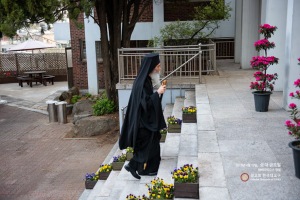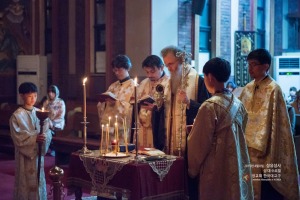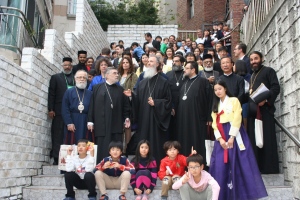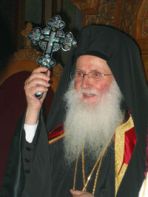Hi readers—it’s Perry checking in with a new post. As most of you know, my area of scholarly expertise is Religious Ethics, with an emphasis on the Eastern Orthodox Christian tradition. Most of you also know that I am an alumnus (and now a trustee) of Holy Cross Greek Orthodox School of Theology, where I completed an M.Div. in 1996 before going on for my Ph.D. at the University of Chicago. I bring this up because our family’s connection to Korea actually started in Brookline, MA, where, as a first-year Divinity student at Holy Cross, I became good friends with a priest-monk from Aegina, Greece, Fr. Ambrosios Zographos. Fr. Ambrosios and I were schoolmates for only a year, but our friendship continued when he went on to Princeton for another Master’s degree, and then the University of Athens for his doctorate in Patristics. One day after defending his doctoral dissertation, Fr. Ambrosios got on a plane to Korea to begin full-time ministry and teaching in Seoul. Today, he is not only a tenured, full-time professor in the Department of Greek and Balkan Languages at Hankuk University of Foreign Studies, he is also the Metropolitan (presiding bishop) of the Orthodox Church in Korea.


Over the past 14 years, I’ve been to Korea 7 previous times, mainly through invitations from Metropolitan Ambrosios to give papers at academic conferences, volunteer with my family at an English Language camp run by the Orthodox Church in Korea, and participate in various symposia and ecumenical events. Before starting my Fulbright, my most recent trip to Korea was to serve as a delegate of the Ecumenical Patriarchate at the 10th Assembly of the World Council of Churches, which was held in the southern port city of Busan in November 2013.

The experience was truly amazing and it sparked the idea for the research project I’m pursuing currently as a Fulbright Scholar, which centers on the impact of this WCC assembly upon the social ethics of the Orthodox Metropolis (diocese) of Korea and upon the ecumenical relations between the Orthodox community and the other Korean Christian communities.
A challenge–and joy–that many scholars experience when doing field work is growing very close with the members of the community on which one’s research centers. Since my family and I are also Orthodox Christians, and we’re renting an apartment here at the St. Nicholas Orthodox Cathedral center, my goal as a researcher is not to pretend quixotically that I’m someone different—someone “objective”—but rather to be as immersed as possible in the local Orthodox community while still asking and pushing critical questions.
Since many future posts will relate to our family’s experiences with the Orthodox community here and to the insights my research yields, I thought a brief history of Orthodoxy in Korea might be helpful. Those looking for more details can check out an excellent 15-minute documentary (click here: documentary video) the Metropolis of Korea’s website (click here: website), or our friend Erik (Spyridon) Lionberger’s lively blog (click here: blog.)
The Orthodox Church’s history in Korea goes back 115 years, when the first missionary priest, Fr. Chrysanthos Shchetkovsky, arrived here from Russia in 1900. In 1903, the first Orthodox parish, a chapel dedicated to St. Nicholas, was established. The Russo-Japanese war in 1904 and the Russian Revolution in 1918 had major negative impacts on the early efforts of Orthodoxy in Korea; not long after this, suffering and restrictions on Koreans during the Japanese occupation, WWII, and the Korea War all posed significant obstacles to the growth of Christianity on the peninsula. However, through contact with Greek soldiers and chaplains during Greece’s alliance with South Korea in the Korean War, the small flock of Korean Orthodox received pastoral support and, in 1955, requested to come under the spiritual care of the Ecumenical Patriarchate of Constantinople. Given the urgency of the request from the faithful in Korea, and the ongoing situation in the USSR, the Ecumenical Patriarchate welcomed the Orthodox community in Korea and began providing clergy and other support to enable the small flock to grow and to cultivate local Korean clergy and leadership.
In 1975, Fr. Soterios Trambas left his high position at the Archdiocese of Athens in order to serve the struggling community in Korea.

His tireless efforts to build the infrastructure, oversee translations, encourage vocations among locals, and minister in countless ways established a solid spiritual and material foundation for the Orthodox in Korea and, in 2004, Ecumenical Patriarch Bartholomew and the Holy Synod elevated the church in Korea to the status of “Metropolis,” naming Bishop Soterios as its first Metropolitan. When Metropolitan Soterios retired for health reasons in 2008, the Holy Synod elected as his successor, Metropolitan Ambrosios.
Today, the Orthodox faithful in Korea number ~5,000, and the Orthodox Metropolis of Korea oversees 9 parishes, one female monastery, and one male monastery. A wide range of pastoral, missionary, and philanthropic activities are carried out by the local clergy and laity, under the spiritual leadership of His Eminence Metropolitan Ambrosios, who serves directly under Ecumenical Patriarch Bartholomew. One of the most extraordinary—and hopeful—characteristics of the Orthodox community here is that it is genuinely pan-Orthodox and united under one bishop, fully congruent with the Church’s historical canonical guidelines. At each of the parishes, native Koreans worship alongside expats from the U.S., Russia, Ukraine, Romania, Greece, Bulgaria, Belarus, Serbia, Canada, and elsewhere. The services are celebrated 95% in Korean, with a bit of English, Slavonic, and Greek blended in. In addition to all of the native Korean clergy, one of the local Orthodox priests, Fr. Roman Kavchak, is a Ukrainian native who was ordained at the Ecumenical Patriarchate and whose primary responsibility is to meet the liturgical and pastoral needs of Slavophone Christians in Korea. His wife, Matushka Lillia, gave birth to their second child…yesterday! (No…I’m not posting photos of the newborn…)
I need to wrap this up, so here is a photo from my family’s experience volunteering at the English Language Youth Camp two weeks ago at the St. Boris Orthodox Church and campgrounds (Chuncheon). Thank you for all your loving support–we miss you but are loving it here!

Perry, your post offered me a chair at your dinner table, a seat in your classroom, a conversation over a cup of coffee.
The background linking you to His Eminence and to South Korea was key to our added understanding of you and your family’s mission of this school year. Thank you.
The great photos are a bonus to this amazing post.
May God continue to bless your endeavors.
LikeLike
Thanks for the quick history! I am sure that every day is a roller coaster in terms of cultural (novel) experiences. keep enjoying… say hi to the family.
LikeLike